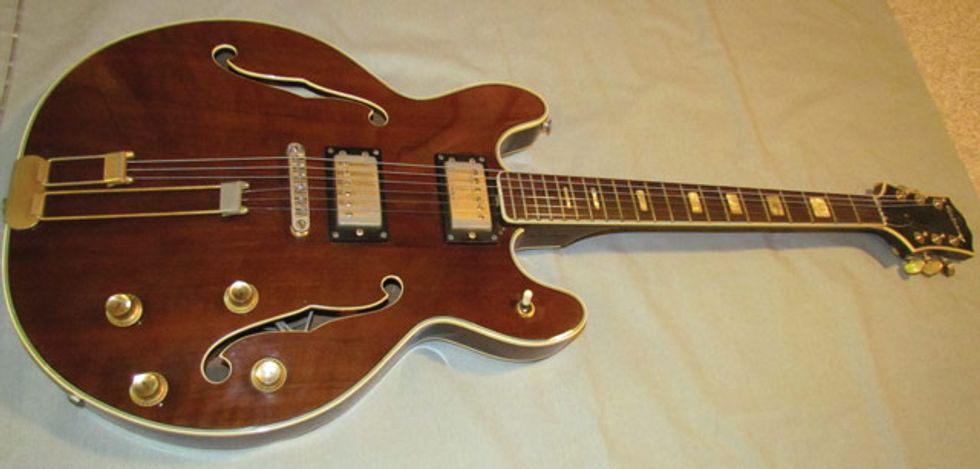An Epiphone
EA255 made by
Matsumoku in the
late ’70s.
I go to a lot of yard sales. Sometimes I get lucky, sometimes I don’t. A few weeks ago, I got a little lucky. A friend of mine was taking part in a neighborhood yard sale and invited me to visit. I had been going to yard sales all morning and didn’t get there until a little after noon, so a lot of sellers were thinking of calling it a day by then. There were several guitars for sale out there. One was an overpriced Ovation, the other was this Epi guitar. It had a sign that said “$150 or make an offer.” It had no strings—usually a bad sign—and the tailpiece was missing. But the seller said the tailpiece was in the case. Aha—a hardshell case was also included. That sweetened the pot a little more. The tailpiece turned out to be a 2-piece Frequensator. I’ve always liked these tailpieces because they look cool.
LEFT: This guitar
sports Epiphone’s
distinctive Frequensator
tailpiece.
MIDDLE: Gold-plated
Grovers—cool!
RIGHT: Unlike vintage
USA Epiphones,
this thinline has a
bolt-on neck.
I carefully examined the guitar. It had gold-plated parts, including Grover tuners—another good sign. It looked like it had been stored in a damp environment—not a good sign—because all the gold parts were corroded and the frets were badly tarnished. The neck had a slight backbow, and that worried me, too. The owner admitted the guitar also had wiring problems, and the jack had fallen off somewhere inside the guitar’s body. I was about to pass on it, but something made me want to save this poor instrument from the grave.
So I started to walk away but offered the seller $75, acting like I wasn’t that interested (yep—that’s Bottom Feeder Tip #221). He wanted to go home and took the $75. Now, we could both go home.
A couple of days later, I took the guitar to Jack Dillen, my go-to guitar repairman in Asheville, North Carolina. I thought about just selling off the guitar’s parts if it was going to be an expensive endeavor to restore it. Jack said we first needed to find the jack inside the guitar and assess what worked—if anything. Jack is such a pro and has all these tricks up his sleeve. I watched him methodically fish the jack out of the f-hole, spray contact cleaner into the pots and selector switch (without having to remove any of them), test all the parts, put the tailpiece back on correctly (after researching which way to arrange it), string it up with a set of .010s, and adjust the truss rod (fortunately, it did turn).
Jack took a guitar that was in pieces and had it up and running just inside of an hour. Impressive—and my repair bill was only $40! For $115 total, I had a nice-playing, 335-style guitar.
Bottom Feeder Tip #2877: Get to know a good guitar tech. They can really save the day.
The Matsumoku company made these EA255s in Japan for Epiphone from 1976– 79. They usually sport gold-plated parts, humbuckers, jumbo frets, lots of binding, and a bolt-on neck. They’re not particularly collectible, but they do have their own sound. This one has a lot of spank and attitude when plugged in.
So is it a keeper? Maybe. The verdict is still out. But I’ll say this—it’s an unusual guitar and now it plays great. Plus, I feel like I helped bring a guitar back from almost certain death and to a playable state again. And that feels good. Guitars are made to be played, not parted out!
 Will Ray
is a founding
member of the
Hellecasters guitar-twang
trio. He also does guitar
clinics promoting his
namesake G&L signature
model 6-string, and produces
artists and bands at his studio in
Asheville, North Carolina. You can contact
Will on Facebook and at willray.biz.
Will Ray
is a founding
member of the
Hellecasters guitar-twang
trio. He also does guitar
clinics promoting his
namesake G&L signature
model 6-string, and produces
artists and bands at his studio in
Asheville, North Carolina. You can contact
Will on Facebook and at willray.biz.








![Rig Rundown: Russian Circles’ Mike Sullivan [2025]](https://www.premierguitar.com/media-library/youtube.jpg?id=62303631&width=1245&height=700&quality=70&coordinates=0%2C0%2C0%2C0)

















